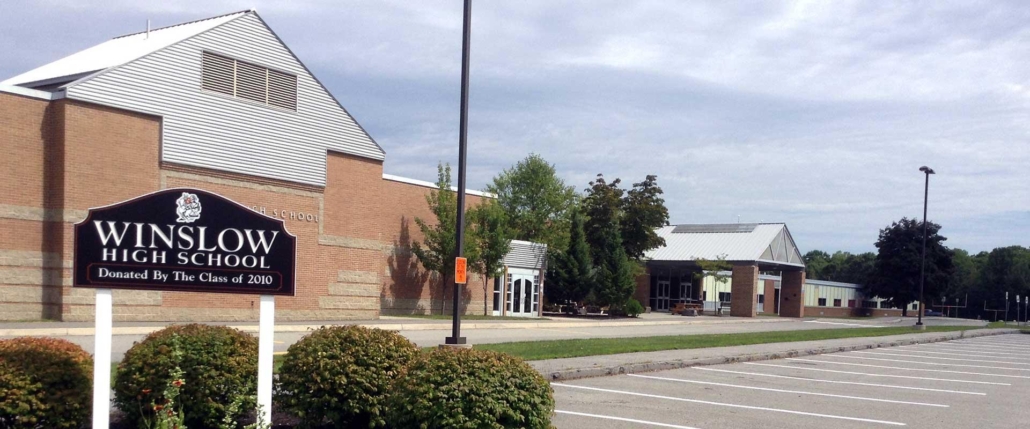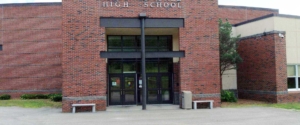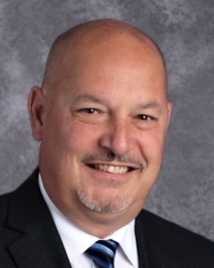How local officials are making our schools safe again

“Both times I visited the school, I was asked my business within seconds of stepping through the front doors.” –Eric Austin (photo source: jmg.org)
by Eric W. Austin
“Nothing’s foolproof,” Augusta Deputy Chief Jared Mills told me at the beginning of our meeting on the issue of school safety. “The best laid plans are not going to prevent this from happening.”
What is ‘this’? Take your pick. Terrorists and school shooters. Bomb threats and bullying. Our students and teachers have a lot to deal with these days.
The fact that nothing is completely foolproof hasn’t stopped our local law enforcement and school administrators from laying down the best possible plans. In researching this article, not only did I speak with Deputy Chief Mills, I also sat down with high school principals Chad Bell, of Winslow, and Paula Callan, of Messalonskee; Headmaster Michael McQuarrie, of Erskine Academy; and Detective Sergeant Tracey Frost, of the Oakland Police Department and one of two school resource officers for RSU #18.
Fifty years ago, schools were primarily designed around the fear of fire. Plenty of exits. Regular fire drills. Today, those concerns have shifted to include “access-point control” and lockdown practice. Fire is still a concern, but now each additional exit or entrance is also a point of vulnerability that needs to be considered. Those changes are obvious by looking at the design of our schools over time. Messalonskee High School, built in 1969, has 37 exits, while the middle school, constructed nearly 50 years later, has only ten.
These warring priorities of access and security are a constant theme for administrators looking to update their facilities for the 21st century.

The front entrance at Messalonskee High is now equipped with a buzz-in system (photo source: jmg.org)
Schools have responded to the new safety concerns in various ways. Messalonskee High School, like many area schools, has implemented a buzz-in system for the front entrance, and keycard-only access for outlying classrooms. Anyone coming to the front door is required to press a button which signals the front office. After verifying your identity, the door is unlocked and you can enter. Winslow High School does not have this system yet, but Principal Chad Bell told me its implementation is at the top of the school’s list of priorities. New policies have been implemented in both schools restricting which exits can be used during school hours in order to more carefully monitor who is entering the building.
Erskine Academy has its own set of challenges. It’s the only school without a full-time school resource officer and, located on the outskirts of China, it faces the longest response time from law enforcement in case of emergency. Though Erskine’s main building does not have a buzz-in system, external classrooms now require keycards to enter, and all classrooms have been fitted with deadbolts that lock from the inside.
Security upgrades have not only encompassed entrance and exit points. Classrooms have also received attention. In older buildings, classrooms were primarily designed to prevent students from being accidentally locked inside. As such, classrooms could always be opened from within, but often could only be locked from the outside, with a key. Now, schools are preparing for situations where being locked inside a classroom might be the safest place for a student to be.

Winslow High School Principal Chad Bell
Winslow has come up with a simple and low-cost solution to the problem. Instead of replacing the outdated locks at significant cost, they have installed a thin, magnetic strip that covers the strike plate of the door jamb. Doors are always locked, but with the magnetic strip in place, they can be closed without latching. In the event of a lockdown, anyone can pull the magnetic strip away from the door jamb and close the door, latching and locking it securely. It’s a simple and elegant solution to a problem that can pose a substantial cost to schools faced with regularly insufficient budgets.
Classroom doors at Messalonskee High School are kept locked but left open so they can be pulled closed at a moment’s notice.
Security cameras have also become a fixture at our schools. Winslow High School has 30 security cameras installed, and although there’s no buzz-in system yet, safety and security are a top priority for the staff. Both times I visited the school, I was asked my business within seconds of stepping through the front doors.
Messalonskee High School has only ten cameras, and the system desperately needs replacing. Installed seven years ago, camera resolution is far below current standards and, after operating 24/7 for nearly a decade, quality has degraded even further. The school intends to replace the system and add more cameras soon, but, as always, cost is the driving factor: new books or new cameras?
Each of these improvements can be taxing on schools scrambling for every cent. Take for example what seems at first a simple problem. Most classroom doors have windows installed in them. Administrators can easily walk the halls and see what is going on in each classroom. But when faced with the worst possible situation, an active shooter in the school, that visibility quickly becomes a dangerous liability. To fix the issue, the windows in classroom doors are now fitted with curtains that can be pulled down from the inside. A fairly easy fix, and cheap. And yet: “At $20 a curtain, roughly,” RSU #18 resource officer Tracey Frost explained, “for hundreds and hundreds of doors across the district? The bill came, but we got it done.”
For Tracey Frost, preparation is key. He aims to make lockdown drills as automatic for students as fire drills, and he thinks he’s almost there. “I can have 800 kids out of a line of sight in under a minute,” he told me proudly. “When we first started doing it, it was maybe two to three minutes.”
The lockdown drills students practice today remind me of the old Nuclear Strike Drills from the 1970s that ended only a few years before I entered school. They start with “LOCKDOWN DRILL! LOCKDOWN DRILL!” blared over the intercom speakers. Students lock classroom doors, pull curtains, and shut off lights. Then they gather in a designated “safety spot” in the classroom, keeping as low as possible, and quietly wait for the all-clear. Or as Tracey Frost puts it: “Locks, lights, and out of sight.”
All of the school administrators I spoke to were in the process of investigating additional training programs to help them prepare for the unthinkable. Three specific such programs seem to be most popular here in central Maine.
“Run, Hide, Fight” is a program endorsed by the Maine Department of Education, and offers a low-cost option with support from the state, but it has its detractors. “I’m not too comfortable with the concept of teaching kids to fight a gunman,” SRO Frost confided, “but I can teach them to stack desks in front of the door. If a bad guy spends 30-seconds trying to get into a classroom and can’t, we’ve saved lives and gained half-a-minute, and that’s a long time in such a situation.”
A.L.I.C.E. (Alert, Lockdown, Inform, Counter, Evacuate) is another popular program many schools are evaluating. It focuses on preparation and planning to, per their website, “proactively handle the threat of an aggressive intruder or active shooter event.”
The final program, which Officer Frost has adapted in large part for schools in RSU #18, is called the Standard Response Protocol. It was developed by the “I Love U Guys” Foundation (iloveuguys.org), an organization started by the parents of a girl killed in the school shooting at Platte Canyon High School in 2006. Frost particularly likes the program’s way of presenting its concepts with colorful, kid-friendly materials, and its method of using what Frost terms “teacher speak:” a common lexicon of terms that make communication between students and teachers simple and unambiguous. The foundation was named after the last text message sent from the girl to her parents before she was shot and killed.

Erskine Headmaster Michael McQuarrie
Beyond lockdown drills and hardening schools and classrooms, everyone agrees the best way to prevent school violence is to develop a culture that makes each student feel understood and respected. “[Students] all have to feel valued,” Erskine’s Headmaster Michael McQuarrie told me at the conclusion of our discussion. “If you’re alienated, if you’re disenfranchised and bullied on top of that — that is an incredible variable that we cannot dismiss or underestimate.”
For law enforcement and school officials both, the introduction of the internet has complicated things, especially in the area of identifying possible threats. In the old days, threats came by way of graffiti on bathroom walls, an anonymous phone call or an overheard conversation.
Today, none of those avenues have disappeared, but now there is also Facebook, Twitter, Snapchat, email, and internet discussion boards to worry about. Add to this the tendency for children to post their thoughts on the internet without fully considering the implications of their words, and it’s common for casual threats to be bandied about on social media platforms with little thought of serious evil intent. In our current safety-conscious climate, however, each of those casual threats must be run down by law enforcement, which takes time away from other, equally important, tasks.
Thankfully, central Maine is still small enough that this hasn’t become the insurmountable effort that it has in bigger urban areas. “We still have the ability to follow up on every tip,” Augusta Deputy Chief Mills assured me. Local law enforcement works closely with the Maine State Police Computer Crimes Unit and the FBI to track down the source of any online threats.
Kids are also figuring out that behavior which might have been viewed as merely mischievous in the past is now considered a serious crime. It starts with parents having a conversation with their kids at home. It continues with teachers and administrators creating a school atmosphere where students feel comfortable bringing their concerns to adults. It ends with law enforcement and the courts, which are dealing out tough sentences for online threats of violence. It’s not unusual for students to be expelled, fined or even jailed for such behavior, as happened in Skowhegan where two boys were recently charged with terrorizing, a class C felony; or in Ellsworth where, this past February, police arrested a 19-year-old student for making threats against the high school in a chat for the online game Clash of Clans.

Messalonskee High’s Principal Paula Callan
New challenges face our schools like never before, with budget shortfalls, teacher shortages, and now safety concerns that would have seemed unthinkable 50 years ago. Still, the brave public servants in our schools are not shrinking from the challenge, and resource officer Tracey Frost is also quick to point out, “[Statistically,] your child is much more likely to get hurt on the drive into school than they are once they enter this building.”
Despite the challenges, school officials are determined to make student safety a priority, whatever the cost. “You can’t put a price on a student’s life,” Messalonskee principal Paula Callan told me firmly, as we shook hands at the end of our talk. In the face of this scary new world, these heroic public servants are taking no chances with the safety of our kids.
Eric W. Austin is a writer and consultant living in China, Maine. He writes about technology and community issues, and can be reached by email at ericwaustin@gmail.com.
Responsible journalism is hard work!
It is also expensive!
If you enjoy reading The Town Line and the good news we bring you each week, would you consider a donation to help us continue the work we’re doing?
The Town Line is a 501(c)(3) nonprofit private foundation, and all donations are tax deductible under the Internal Revenue Service code.
To help, please visit our online donation page or mail a check payable to The Town Line, PO Box 89, South China, ME 04358. Your contribution is appreciated!





There are hundreds of thousands of retired veterans/first responders/unemployed vets throughout the country who would gladly volunteer to protect their kids, grandkids and the rest of the school. This has been my suggestion since this garbage started. These men and women have the training and experience to be the most effective and cost effective option.